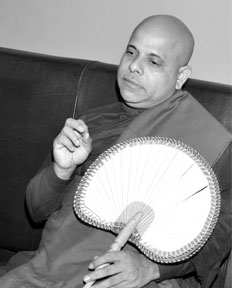Rain retreat ends on Vap Full Moon Poya day
By Ananda Kannangara
The Vap Full Moon Poya is a very significant Poya in the Buddhist
calendar. According to Buddhist history, many events related to the life
of the Buddha occurred on this Poya day.
It was on a Vap Full Moon Poya day that the Buddha ended His seventh
(Vassana) retreat for the rainy season since His Enlightenment which He
had spent in the celestial abode of Tavatissa. There He had engaged in
preaching Abhidhamma to the devas and deities headed by Matrudeva.
Accompanied by a procession of devotees, the Buddha descended near the
city gates of Sankassapura, whereupon having preached Dhamma to the
great crowds which flocked to witness the strange event, He declared
Arahat Sariputta as the most intelligent person among all the disciples
when he successfully answered various difficult questions put to him by
the Buddha.
 |
|
Ven. Wennawatta
Ratanajothi Thera.
Pic: Sarath Peiris. |
During the ancient era, Vap was known as the period of sowing. The
major cultivation season is known as ‘Maha’ which begins with the
inter-monsoonal rain around the month of October.
Rainy season
The rainy season began three months ago. It is called ‘Vassana Kalo’
and it ends with the Vap Poya and the ‘Katina’ season begins with the
month of Vap. This Poya is also known as 'Cheevara Masaya'. It marks the
offering of ‘Katina cheevara’ or new robes to Bhikkhus who observed Vas
season beginning on the Esala Poya (July) to Vap Poya (October).
Accordingly, the ‘Katina’ period lasts from Vap Poya (October) to Ill
Poya (November).
The presentation of ‘Katina cheevara’ is a meritorious deed. ‘Katina
cheevara’ are bought by the laity and presented to the temple on the
‘Katina pinkama’ day.
Before giving the ‘Katina cheevara’ to the temple, devotees carry it
in a procession.
The word ‘Katina’ means ‘unbreakable'. It is like a solid rock and
the merit gained by offering robes to bhikkhus cannot be shaken.
According to Ven. Wennawatta Ratanajothi Thera of the Dekatana,
Namaluwa, Purana Vihara, holding and taking part in a ‘Katina pinkama’
is a great meritorious deed.
He said only one ‘Katina pinkama’ should be conducted at a temple.
Only one Bhikkhu is entitled to the ‘Katina cheevara'.
Religious activities
During the ‘Vas’ period, Bhikkhus should stay indoors and perform
religious activities such as conducting Dhamma sermons and meditation.
There is a belief that those who participate in ‘Katina’ religious
activities receive a lot of merit that would help them to lead a happy
life.
Ven. Ratanajothi Thera said although most Buddhists participate in
religious activities during the ‘Vassana’ season, only a few know its
history and the origin. No one seems to know why Bhikkhus stay indoors
and engage in religious activities during the three-month period from
July to October every year.
During the Buddha's time there were nearly 100 religions in India.
Among them were Brahminism, Jainism, Achelaka, Paribrajaka, Thapasa,
Jatila and Nigantha.
The monks of these religions stayed indoors for three months from
July to October due to heavy rains. They believed that the rainy period
belonged to worms and plants. They thought that if they walked, the
worms and plants would die.
Staying indoors
Thereafter, the Buddha too set an example by asking Bhikkhus to stay
indoors during the ‘Vassana’ season.
Religious activities conducted during the ‘Vassana’ season help to
promote unity between Bhikkhus and laymen.
Although Bhikkhus stayed indoors and ‘Katina’ pinkamas were conducted
during the Buddha's time, they did not receive new robes. They had to
use white clothes that were used to wrap dead bodies. The clothes were
cleaned and soaked in saffron coloured water before use.
The Bhikkhu who uses the ‘Katina cheevara’ should use for at least
for six months from October to March in the following year.
Ven. Ratanajothi thera said a ‘Katina perahara’ (procession) should
be conducted in a proper manner. The perahara should be conducted in a
dignified way without using whip-crackers, fireball players, elephants
and dancers. Buddhist flags and flowers should be carried by the
participants.
The appointment of Sariputta Maha Thera as the chief disciple of the
Buddha also took place on the Vap Poya day.
It was on a Vap Poya day that King Devanampiya Tissa sent a
delegation to meet Emperor Asoka in India. The delegation was led by
Prince Aritta. When the King inquired from Ven. Mahinda Thera whether
Buddhism had taken root in the island, the Thera answered in the
affirmative.
|


